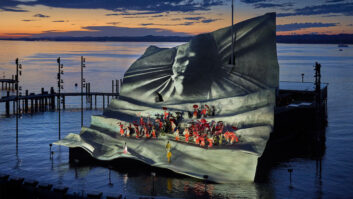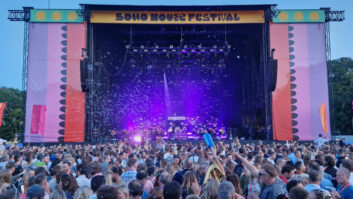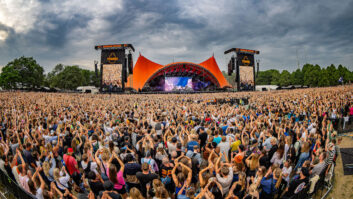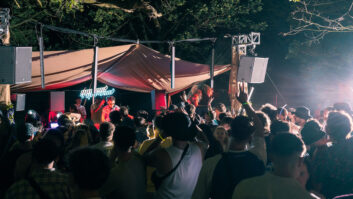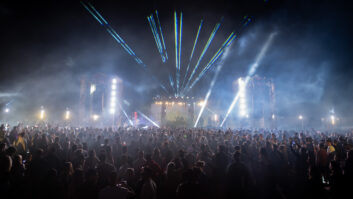Two childhood friends from Athens, Georgia recently graced the stage at the 2016 Aspen Music Festival and School (AMF) for a unique project blending rock and orchestral music. Penning Concerto for Rock Band, Violin and Strings to feature celebrated violinist Robert McDuffie, R.E.M. bass guitarist/keyboardist Mike Mills joined his friend and an array of musicians for what might have been the high point of a notably exciting summer of performances in Pitkin County, Colorado. Following Concerto’s AMF performance, Mills and McDuffie began a U.S. tour with the Chicago Chamber Orchestra in Miami, which continues through late November.
Planning to meet the needs of this complex event was no small task for the Aspen Music Festival’s audio engineering team, which includes engineers Adam Borecki, Jim Donahue, Maggie Luthar, Kyle Martin and Scott Wynne. Already unique in scope, Concerto for Rock Band, Violin and Strings added an extra layer of complexity to AMF in coordinating the various needs of the artists and live audience as well as future broadcast-based listeners and viewers.
For Mills’ Concerto, the ante was raised via unique needs such as intricate monitoring schemes utilizing both stage wedges and in-ear monitors, multiple mixes for multiple purposes, and audio feeds for future planned broadcasts. NARAS was on site with a four-camera video crew to capture the event.
“Following a performance in Toronto [where Concerto debuted], they sent us an input list of about 62 microphones and two cue mixes,” recalls Wynne. “Meanwhile, we had a 12-channel Soundcraft board at front-of-house…a little complication, to say the least.”
With gear sponsors including Focusrite RedNet, Wynne and his colleagues quickly organized an audio network-based plan to best cover the event. “Jim and I sat down with the input list and the production manager for R.E.M. to narrow down what we thought we could get away with, microphone-wise,” tells Wynne. “Jim and I thought it would be either an incredible nightmare or an amazing feat if we could make everything RedNet.”
Receiving 32 channels via Focusrite’s MP8R and using one RedNet 2 (featuring 16 channels of I/O) for outputs to the venue’s speaker arrays, cue mixes and front-fills, Wynne centered the system on a rented Yamaha QL5 at front-of-house and a RedNet 6 MADI bridge, connecting to AMF’s Lawo mc2 series mixer, designated for recording purposes. “It was a matter of getting all that infrastructure in place—the pres’ dropped, the speakers up, recording world happening, clocking off of the incoming MADI stream from the Lawo board, then doing the multitrack with a mix on the fly and the front-of-house mix,” Wynne offers. “They had me doing front-fills, three cue mixes, three monitor mixes, plus loft speaker and stage speaker mixes—roughly eight mixes running at once. Yet we were able to get it up and running very easily with RedNet.”
Violinist Robert McDuffie leads R.E.M. bass guitarist/keyboardist Mike Mills and a collection of string players for Mills’ own Concerto for Rock Band, Violin and Strings.

Ample and knowledgeable help from the rest of the team helped the event take off with nary a hitch. “Heading the recording team was Kyle Martin—who loves doing rock bands and did a stint at Banff Centre—as lead recording engineer,” credits Wynne. “Senior engineer Maggie Luthar assisted Kyle. Adam Borecki helped out everywhere; if we needed mics dropped or RedNet tested, Adam was there. Jim helped in much the same manner, even coming in on his day off to make sure everything went smoothly.”
Covering the audience was daunting, as a ceaseless schedule required the audio team to work around the needs of other orchestral-based performances before and after the Mills/ McDuffie extravaganza, not to mention making sure that all involved received most of their requests. “This is what we’d call a ‘malleable PA system,’ because as we set up one thing, we found out we needed more,” Wynne recalls. “Going back to the ‘many heads of the hydra,’ this [performance] had a lot of different opinions involved— the artist, the artistic opinions of associated management and friends, and the other orchestra performances going on. We couldn’t fly the line array because we had two orchestras before the rehearsals that didn’t want it hung, and meanwhile we needed to use the line array in the back of the choir loft as a stacked system.”
As such, the audio team utilized an amalgamated rig consisting of four EAW subs, two per side and two early JBL VerTec speakers, “on top of the subs for coverage of left and right, yet very far left and right due to the shape of the stage,” says Wynne. “The first night [of rehearsals], we had to move the band back; they wanted to be very down stage but were getting a lot of feedback. We then added front-fills, too; using JBL passive speakers, they still weren’t enough, so we added in another pair of JBLs more as front-fill to cover over the orchestra section. Next, we added two more VerTecs in the choir loft to cover the very top and edge of the audience. Some may laugh at the setup, but they don’t know the backstory of what had to go in, what had to come out, and what had to be restacked and positioned so that [other] performances and orchestras felt like we weren’t impeding their performance or stage time.”
Aspen Music Festival and School
aspenmusicfestival.com

